Monsanto Go Away
As part of the Occupy Maui movement, The Human Revolution has a clear message for Monsanto.
More on Monsanto on The Road.
Read the full post...
Life as a serial expat, addicted traveller, desperate adventurer, wannabe sailor and passionate aidworker

- Emergency seed aid should be used only to address emergency problems, and those in which seed security is a problem. Note that current farmer projections for August/September 2010 suggest that farmers can access the seed they need.
- Any seeds made available to farmers through aid interventions have to be shown to a) be adapted to local conditions, b) fit well with farmers preferences, and c) be of a quality ‘at least as good’ as what farmers normally use. One should never introduce varieties in an emergency context which have not been tested in the given agro-ecological site and under farmers’ management conditions. (..)
- Direct Seed Distribution (DSD) is best used when there are problems of seed availability.(Several agro-dealers in Léogâne indicated they had substantial supplies of maize seed unsold while free seed aid was being delivered. Business was being compromised at the critical moment it needed to be strengthened. While Léogâne is somewhat unique in currently having an input dealer network, such outlets will likely become more numerous in near future: these should be supported, rather than undermined). (...)
- Novel improved varieties should generally not be introduced to a broad population in the context of an emergency distribution. (...)

U.S. agriculture giant Monsanto Co. is donating $4 million worth of seeds to Haiti, the biotechnology manufacturer's first major foray into the chronically hungry nation.Nothing wrong, you might say... Nice gesture... However:
The corporation, based in Creve Coeur, Missouri, announced a pledge this week of 475 tons (431 metric tons) of corn and vegetable seeds. Some 130 tons (118 metric tons) have been delivered and are on their way to farmers as of Friday.
"We looked at what would be well-suited to Haitian growing conditions," said Elizabeth Vancil, the company's development partnership director.
Farmers will have to buy the seeds at markets to avoid flooding the local economy with free goods, but Monsanto will not receive any revenue from the sales, Vancil said. A spokesman for the U.S. Agency for International Development program distributing the seeds could not immediately provide more details."USAID could not provide details"...:
The announcement raised concerns in Haiti that the donation would include genetically modified seeds, for which the country does not have a regulatory system. Monsanto representatives said no such seeds will be included.Monsanto on the road to sainthood? Hardly:
Instead they are sending hybrid seeds, which are produced by manually cross-pollinating plants. The company said the seeds produce larger yields than non-hybrid seeds, but that with such a variety new seeds have to be purchased and planted every year.Aha.. So, the seeds come for free. This year. Even though the farmers will have to buy the seeds, but hey, good for the local economy. The seeds produce a plant, which generates seeds, but not as good as the hybrid.
The Monsanto representative in Haiti is Jean- Robert Estimé, who served as foreign minister under the Duvalier family's 29-year dictatorship."... Ah, the Haitian connection, hey?
Monsanto had already donated money, but it was clear that a donation of our products -corn and vegetable seeds- could really make a difference in the lives of Haitians.Well, the link on their blog covering the "donation" showed $50,000 to the American Red Cross The Disaster Relief Fund, to prepare for future disasters. So not tied to Haiti.
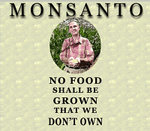 It seems the "World according to Monsanto" video I posted a while back was removed from YouTube. I have found new links, including a link to BitTorrent, and updated them on my original post.
It seems the "World according to Monsanto" video I posted a while back was removed from YouTube. I have found new links, including a link to BitTorrent, and updated them on my original post.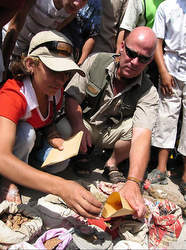 ABC’s documentary “Seed Hunter” takes you on a modern day "Indiana Jones"-style search for the Holy Grail of Seeds: the wild chick pea.
ABC’s documentary “Seed Hunter” takes you on a modern day "Indiana Jones"-style search for the Holy Grail of Seeds: the wild chick pea.
"Gene detectives", like Dr.Ken Street, hunt this rare seed variety for its ultimate heat and cold resistance. A seed with a gene that could help us grow food withstanding 21st century global warming.
This video is a must-see odyssey from the Middle East to the mountains of Tajikistan into the Arctic doomsday vault. (Watch)
Thanks to my Friend E for the link!
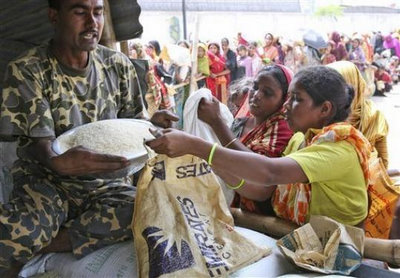
Giving people fish or teaching them to fish?
A few years back, I had a meeting with Sheikh Mohammed bin Rashid Al Maktoum, the Ruler of Dubai, Prime Minister and Vice President of the UAE.
I told him of the humanitarian work we did. He listened attentively, and kept a silence after my explanation. Then he said candidly: "You know, you are giving people fish, instead of teaching them how to fish. Give a person a fish and he will eat for a day, teach him how to fish and he will have food for the rest of his life!"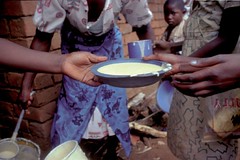 I was quick to respond: "Your Highness, when people are starving, they are not interested in being taught how to fish. If we give them fishlings for their pond, they will eat it, rather using them for breeding. Our organisation gives people the fish, so they are not starving anymore, and have the energy to be taught how to fish, and to fish themselves. Other organisations we work closely with, teach them how to fish, how to breed fishlings. After that, others come in and teach them not to overfish their pond, or even to market their excess harvest, set up funding mechanisms to sell their harvest beyond their own village. We all work hand in hand, each of us has its own role."
I was quick to respond: "Your Highness, when people are starving, they are not interested in being taught how to fish. If we give them fishlings for their pond, they will eat it, rather using them for breeding. Our organisation gives people the fish, so they are not starving anymore, and have the energy to be taught how to fish, and to fish themselves. Other organisations we work closely with, teach them how to fish, how to breed fishlings. After that, others come in and teach them not to overfish their pond, or even to market their excess harvest, set up funding mechanisms to sell their harvest beyond their own village. We all work hand in hand, each of us has its own role."
How true are we to our aid commitments?
This was then. But at this moment, there is a growing concern and dissatisfaction in the aid world. How well have we done in the past decades. Have we really followed our own reasonings and explanations..? Or were they mere justifications for our own existence?
The global food crisis hitting the poorest people first, is an objective proof we - the international aid community - have not done well enough. Have we - all of us - not concentrated too much on giving people fish, rather than teaching them how to be independent from foreign aid? How much of it could have been avoided? How can we learn from our lessons?
While the international focus is on the global food crisis, it is the right time to highlight the importance of not only concentrating on short term solutions. Short term solutions for hunger are like drops of water on a hot plate. Let's give people fish, but also concentrate on "teaching them how to fish".
In the context of the global food crisis, this means concentrating not only on emergency food aid, but also on achieving sustainable food security and reducing poverty in developing countries through non-for-profit and transparent scientific research in the fields of agriculture, forestry, fisheries, policy, and environment.
I explicitly exclude the agricultural research done by the likes of Monsanto and Cargill, international commercial giants who only aim at increasing their profit margin, often to the detriment of the farmers in poorer countries.
Let's rather have a look at the benevolent work of organisations like the CGIAR, the Consultative Group on International Agricultural Research.
Agricultural aid research, a proven success.
The CGIAR has a proven success track record (Source): - Successful biological control of the cassava mealybug and green mite, both devastating pests of a root crop that is vital for food security in sub-Saharan Africa. The economic benefits of this work are estimated at more than $4 billion.
- Successful biological control of the cassava mealybug and green mite, both devastating pests of a root crop that is vital for food security in sub-Saharan Africa. The economic benefits of this work are estimated at more than $4 billion.
- Increasing smallholder dairy production in Kenya improving childhood nutrition while generating jobs. This award-winning project with smallholder dairies has contributed up to 80 percent of the milk products sold in the country.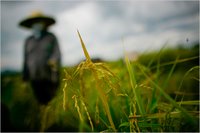 - New rice varieties for Africa, which combine the high yields of Asian rice with African rice’s resistance to local pests and diseases. Currently sown on 200,000 hectares in upland areas, they are helping reduce national rice import bills and generating higher incomes in rural communities.
- New rice varieties for Africa, which combine the high yields of Asian rice with African rice’s resistance to local pests and diseases. Currently sown on 200,000 hectares in upland areas, they are helping reduce national rice import bills and generating higher incomes in rural communities.
- An agroforestry system called “fertilizer tree fallows,” which renews soil fertility in Southern Africa, adopted by than 66,000 farmers in Zambia.
- Widespread adoption of resource-conserving “zero-till” technology in the vital rice-wheat systems of South Asia. Employed by close to a half million farmers on more than 3.2 million hectares, this technology has generated benefits estimated at US$147 million through higher crop yields, lower production costs and savings in water and energy.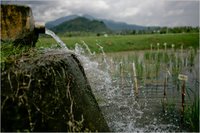 - A flood-tolerant version of a rice variety grown on six million hectares in Bangladesh. The new variety enables farmers to obtain yields two to three times those of the non-tolerant version under prolonged submergence of rice crops, a situation that will become more common as a result of climate change.
- A flood-tolerant version of a rice variety grown on six million hectares in Bangladesh. The new variety enables farmers to obtain yields two to three times those of the non-tolerant version under prolonged submergence of rice crops, a situation that will become more common as a result of climate change.
- A new method for detecting and reducing by 100% aflatoxin, a deadly poison that infects crops, making them unfit for local consumption or export benefiting farmers throughout sub-Saharan Africa.
- More than 50 varieties of recently developed drought-tolerant maize varieties being grown on a total of about one million hectares across eastern and southern Africa
- A simple methodology for integrating agriculture with aquaculture to bolster income and food supplies in areas of southern Africa where the agricultural labor force has been devastated by HIV/AIDS, doubling the income of 1,200 households in Malawi.
- Etcetera, etcetera, etcetera....
Digging our own grave.
All good news. Except that the focus on emergency food aid seems to have drawn worldwide attention - and funding - away from long term agricultural research. Proof of the matter is that while U.S. President George W. Bush recently ordered up $200 million in emergency food aid, with a follow-up of another $755 million, the U.S. Agency for International Development (USAID) is cutting as much as 75% of their funding to the CGIAR (See Science Magazine). USAID's support to the CGIAR in 2006 was $56 million or about 12% of the CGIAR’s core budget.
And USAID is not the only one to blame. Look at this graph illustrating the worldwide trend of foreign aid (which excludes relief aid - as the graph would then look even worse!) going up, versus the downward trend of in agricultural aid.
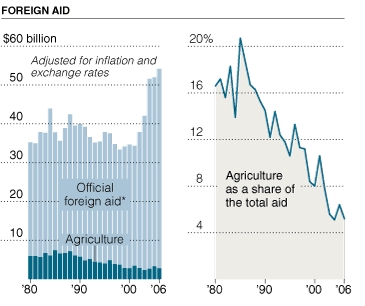
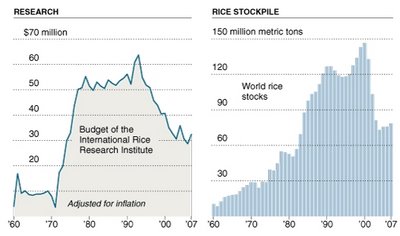
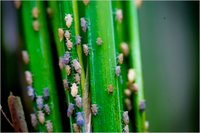 The brown plant hopper, an insect no bigger than a gnat, is multiplying by the billions and chewing through rice paddies in East Asia, threatening the diets of many poor people. China, the world’s biggest rice producer, announced on May 7 that it was struggling to control the rapid spread of the insects there. A plant hopper outbreak can destroy 20 percent of a harvest.
The brown plant hopper, an insect no bigger than a gnat, is multiplying by the billions and chewing through rice paddies in East Asia, threatening the diets of many poor people. China, the world’s biggest rice producer, announced on May 7 that it was struggling to control the rapid spread of the insects there. A plant hopper outbreak can destroy 20 percent of a harvest.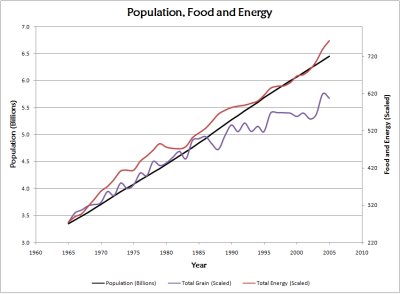
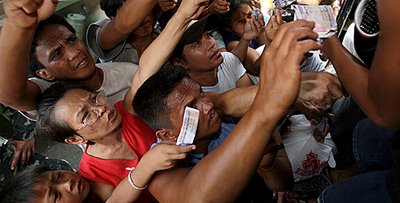
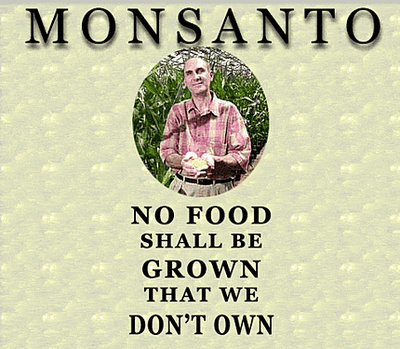
The story starts in the White House, where Monsanto often got its way by exerting disproportionate influence over policymakers via the “revolving door”.
One example is Michael Taylor, who worked for Monsanto as an attorney before being appointed as deputy commissioner of the US Food and Drug Administration (FDA) in 1991. While at the FDA, the authority that deals with all US food approvals, Taylor made crucial decisions that led to the approval of GE foods and crops. Then he returned to Monsanto, becoming the company’s vice president for public policy.
Thanks to these intimate links between Monsanto and government agencies, the US adopted GE foods and crops without proper testing, without consumer labeling and in spite of serious questions hanging over their safety.
Not coincidentally, Monsanto supplies 90 percent of the GE seeds used by the US market. Monsanto’s long arm stretched so far that, in the early nineties, the US Food and Drugs Agency even ignored warnings of their own scientists, who were cautioning that GE crops could cause negative health effects.
Other tactics the company uses to stifle concerns about their products include misleading advertising, bribery and concealing scientific evidence.
Monsanto's background
Monsanto was founded in 1901 as a chemical company. Its history is intimately linked to the production and promotion of highly toxic chemicals such as Agent Orange (used as a chemical weapon in the Vietnam war) and PCBs (widespread toxic pollutants).
Robin’s movie reveals that Monsanto already knew about the “systematic toxic effects” of PCBs for decades, but instructed its salespeople to stay silent because, “we can’t afford to lose one dollar.”
More recently Monsanto received a bad reputation for the promotion of growth hormones from GE organisms known as rBGH, which the company sells in the US under the brand name Posilac.
Monsanto claims that Posilac holds, “benefits to consumers”. The reality is that, rBGH growth hormones were banned in Europe and Canada after the authorities found out about the health risks resulting from drinking milk from cows treated with rBGH hormones.
Monsanto's way of "addressing" this problem was to sue the Oakhurst dairy company in the state of Maine (US) - attempting to force them, and other dairies, to stop labelling diary products “rBGH-free” and “rBST-free”.
Global reach, control
Over the last decade, Monsanto aggressively bought up over 50 seed companies around the globe. Seeds are the source of all food. Whoever owns the seeds, owns the food.
The process of genetic engineering allows companies, such as Monsanto, to claim patent rights over seeds. Ninety percent of all GE seeds planted in the world are patented by Monsanto and hence controlled by them. Patents on seeds give companies like Monsanto unprecedented power.
Monsanto prohibits farmers saving patented GE seeds from one crop to replant the next season, an age-old practice. To ensure that farmers do not reuse seeds, Monsanto created its own 'gene police', and encourages farmers to turn in their neighbors.
Even farmers that do not use GE seeds are not safe. According to an investigative report by the Centre for Food Safety (CFS) farmers have even been sued for patent infringement after their field was contaminated by pollen or seed from someone else’s GE crop.
But Monsanto’s influence doesn't stop at the US border. “The world according to Monsanto”, documents the devastating impact of Monsanto's malpractices around the world. Among others, it includes the real-life stories of cotton farmers in India that ended up in hopeless debts after using Monsanto genetically engineered (so called Bt) cotton, and of a family in Paraguay, South America whose dreams have turned to nightmares after their farm became surrounded by fields planted with Monsanto’s GE soya.
A much needed expose
Monsanto wouldn’t address these issues on camera for Robin, instead referring to the "Monsanto Pledge" posted on their website (which we debunk here).
The movie was shown for the first time on ARTE TV (in German and French) on Tuesday 11 March. You can order a DVD of it (in English, French and Spanish) here.
© Blogger template The Business Templates by Ourblogtemplates.com 2008
Back to TOP
The Road's Dashboard
Log in
New
Edit
Customize
Dashboard